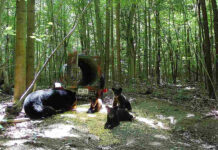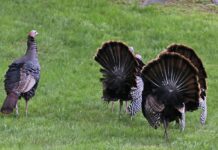The dairy farmer will look over the cow pen and notice the cows are bunched up and huddled into a big group. The farmer scratches his head and asks, “Why do cows congregate into a group?” They were not like that before. Unsure of what to do, he gets in the pen and separates the cows, only to find the same group of cows an hour later bunched up again.
Why does it matter
When cows bunch together it compromises production, health and welfare of the animals. Bunching increases heat stress of the affected cows, increases standing, splashes manure on the udder and elevates stress hormones. These changes increase risk of lameness, reduces ruminations and feed intake and results in loss in milk production that is lower in butterfat.
Cows with stress do not perform well. Bunching of cows is an indicator of some external stressor not initiated or solicited by the farmer.
Why do cows bunch
Cows were created with a four-chambered stomach to consume grass meals during daylight hours and then retreat to a safe location and reside as a herd for protection. Herd animals stay together as a group with a social dominance structure.
Cows, sheep and wild animals like deer, zebra and wildebeest, are ruminant prey animals. Prey animals will congregate together in herds and bunch for protection and survival.
In the wild, the wildebeest grazing on the African safari grass will bunch together as a predator cheetah approaches the herd.
We don’t have cheetahs in our dairy barns as a threat to our cows but the response to a stress is similar — bunch together! Cows will bunch together to satisfy the God-designed instinct for protection as a herd and avoid pain or stress.
Bunching can occur in well-managed dairy barns as a result of stress from social interactions, hot weather, noises from external fans, flies, electrical stimuli like stray voltage, odors, stalls, wet flooring, overcrowding, feed quality and water availability.
Social interactions
Cows reside in herds where a unique social dominance hierarchy exists. The “boss cow” is the mature cow that gets her way. Driven by the desire to eat at the prime feed bunk location she also selects the choice free stall and ideal parlor stall. She will dictate her preferences with head butting, ear twitching and tail movement responses.
The dominant “boss cow” will direct the herd with subordinate followers. Free stall housed cows will socialize in groups of 10-12 cows of similar size that were raised together. The lower social order cow is typically the first calf heifer that recently calved.
Social hierarchy and conflict stress are most significant in pens of milking cows of all lactation ages. Research has proven that first calf heifers perform better when housed in a separate pen from older cows. This is partly due to less social distress. If your facilities allow, a separate first calf heifer group is beneficial.
Social stress will cause cows to bunch up. The boss cow that dominates at the feed bunk or water tank will restrict the lower social order cows. These lower social order cows will often be the first to bunch from a stressor. Increased pen head count especially during hot weather or other stressors will cause these lower social order cows to begin to bunch.
Environmental temperature
Cow bunching can start with as few as three to five cows that are initially stressed. As environmental temperature increases, more cows are affected and the bunching group grows in size.
Research and time-lapse camera observations in free stall barns would indicate the most frequent time to observe bunching is 3 to 8 p.m. The initial bunching can start when temperatures are at 68 F or higher.
Walk your barns in late afternoon each day and observe what the cows are telling you. If they are standing more and bunching in groups of three to six cows, or standing near a drinker, then evaluate the cause and implement a solution quickly. Once cows learn to bunch it is difficult to stop the behavior.
Fan noise and dirty fans can be a source of cow bunching in hot weather. Cows hear higher frequency sounds, 8000 Hz, compared to people, 1000 to 4000 Hz. Fan noise can elicit a stress response and create bunching.
Repair squeaky or noisy fans and clean fan blades and housing mesh. Dirty fans move less air and will create areas of the barn that do not offer airflow. Consult with a qualified ventilation technician and cow comfort specialist to evaluate your barns if bunching occurs.
Microclimates
Barns can have regions of stale air, manure odors, fan noises or sun rays that create microclimates within the barn. These microclimates elicit a stress response in selected cows that will bunch.
The external perimeter of the barn can also impact the internal barn environment. A California dairy study from 20 large dairy farms indicated that crops grown adjacent to free stall barns can elevate potential for cow bunching by modifying internal barn airflow in selected areas. Trim weeds and brush growing near free stall barns and do not plant corn crops close to free stall barns.
On pasture cattle, cows will bunch in the hot conditions under a tree to avoid direct sun rays. Free stall-housed cows are blocked from direct sunlight during midday. However, radiant direct sun into barns occurs in the early morning or late afternoon. Ventilated shade cloth on the barn sides will reduce direct sun light exposure.
Electromagnetic fields
Farmers have perceived magnetic fields from high voltage lines, automated milking systems or solar panels as possible causes of bunching behavior in their cows.
Housed dairy cows are a greater risk for stray voltage than pastured animals due to the exposure of fans, parlor, automatic milking and electric panels in housed barns. Dairy cow sensory stimuli start at a much lower voltage than humans.
Several farms indicated that bunching of cows occurred in close proximity to fans where wind speed was excellent. The cause of the bunching was attributed to hot spots in specific barn regions where fans were not located. Cows located themselves in front of the fans to avoid the hot regions in the barn.
Cows will also bunch in areas of good airflow to avoid flies. Fans are electronic devices that can cause stray voltage when in use and, if not properly grounded, can create stress and cows will bunch. One US research study indicated that the noise from fans can initiate a stress response in cows and initiate bunching.
Pests
Stable flies are blood seeking flies that bite the legs of cattle. A California study measured fly counts on cows using traps and daily visual cow observations. The fly traps indicated as few as four flies on the cow’s legs caused cows to bunch in free stall pens.
Dairy cows are known to have thinner hides than beef cattle and dairy cows are more susceptible to biting flies. Fly repellent behaviors include tail flicking, foot stomping, head tossing, skin twitching and ear trembling to reduce the fly attack.
An effective fly control program must include a combination of cleanliness, feed through larval control, regular sprays, ear tags and routine cleaning. Fly control must start early, April or May, to prevent mid to late summer fly issues. Remove pen pack manure and old feed, and drain standing water as these can be a source of flies.
Feed and water
Cattle will increase drinking in hot temperatures and they will often bunch around drinkers in hot temperatures. Provide extra waterers during the summer. Drinkers should provide a minimum of 25 linear water distance per 100 cows. Water capacity, as measured by flow rate, is also important so that the drinkers are not empty.
Total mixed ratio, TMR, feed bunks must provide continuous access to fresh feed. A mold inhibitor added to the TMR will maintain freshness and stability of the ration during hot summer months. Provide a minimum of 200 feet of bunk length per 100 cows or 24 inches per cow.
Overcrowded pens or limited bunk space with limited feed intake will create opportunities for cows to bunch up, especially during hot weather.
Summary
Take time now to get the barns in order for summer time. Cow bunching can be prevented but it requires a preventative approach. Don’t get “farm blindness” where your cows bunch up. Keep the predators of stress away with proper prevention.
Areas to manage to prevent bunching this summer include effective cleaning of fans, proper fly control, trim grass and weeds around barns and check for stray voltage, especially on fans and drinkers. Most of all, observe the barns each afternoon to observe and head off any potential stressors that may cause cows to bunch up.













